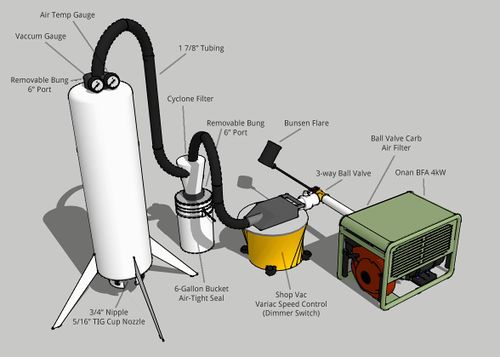Charcoal Gasifier: Difference between revisions
Jump to navigation
Jump to search

(Updated the Page to the Most Recent Formatting Standards) |
m (Minor Clarification) |
||
| Line 18: | Line 18: | ||
</html> | </html> | ||
= | =Internal Links= | ||
*[[Gasifier 3D CAD]] (For OSE’s Latest Design) | *[[Gasifier 3D CAD]] (For OSE’s Latest Design) | ||
*[[Compressed Fuel Gas]] | *[[Compressed Fuel Gas]] | ||
Revision as of 20:58, 12 October 2025
Basics
- There are some advantages with using charcoal (rather than wood) for gasification (section taken from: Troy Martz Gasifier). These may include:
- Sufficiently drying wood/biomass to an appropriate water content % takes days. Charcoal can be made and used in mere hours.
- The byproduct of charcoal sizing (anything under 1/16th of an inch) just happens to be perfectly sized for biochar...w hat a great byproduct to have
- We don’t have to worry about tar! Thus, filtration in the down line is relegated to ash and dust… easily done.
- Pure carbon is a perfect catalyst for the reduction process… You never really get 100% there with biomass.
- We eliminated “pyrolysis” from the problem we’re trying to solve, so the gasifier design becomes infinitely more flexible than the “Imbert” design
- We can scale gas production with the same system by merely swapping out a single nozzle size – we can go from 2kW to 50kW with the same machine!
- Yes, charcoal has less BTU’s, but we can also utilize those BTU’s by capturing and using that heat with a smart charcoal retort design
- Charcoal gasifiers have the potential to produce far more powerful gas flow than biomass gasifiers... Cracking steam is the key.

Troy Martz Gasifier - gasifies charcoal
Videos
Internal Links
- Gasifier 3D CAD (For OSE’s Latest Design)
- Compressed Fuel Gas
- Troy Martz Gasifier - gasifies charcoal
- Biomass to Fuel
- The Biochar Economy and Kon-Tiki Kiln